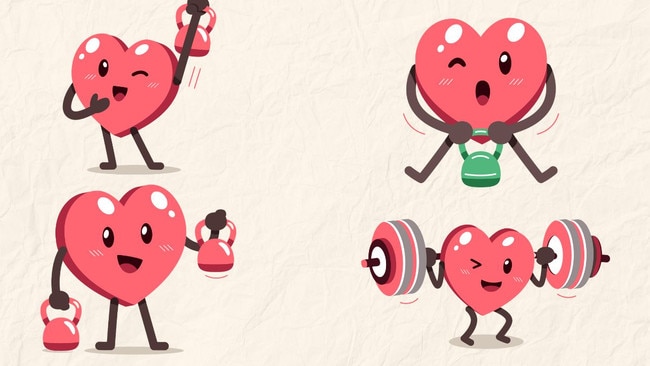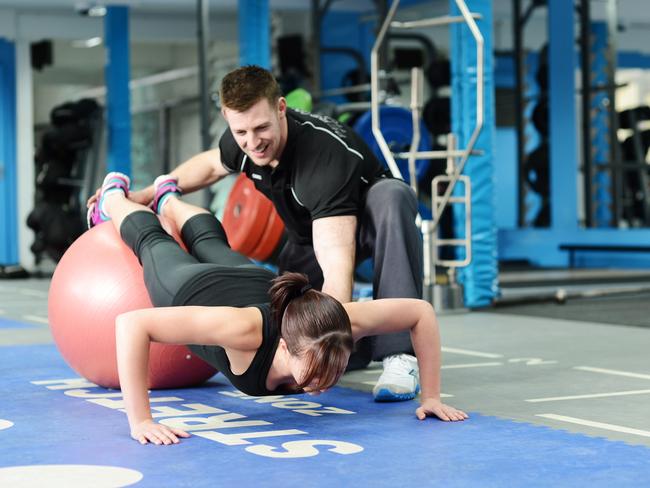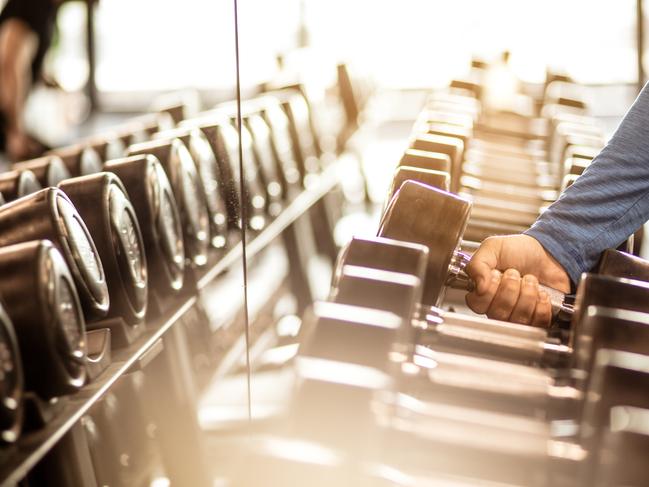Is your heart at risk from fatty muscles?
A new study has highlighted the dangers of fat buried deep within our muscles. This exercise plan will help to reduce intermuscular fat and build power.

Most of us are aware that the build-up of visceral fat stored around internal organs is linked to metabolic disease including type 2 diabetes, but researchers from Harvard University are now warning that fat hidden within our muscles also poses a significant medical risk.
For their new study, published in the European Heart Journal, Professor Viviany Taqueti and her team showed that people with high levels of it were more likely to experience heart attacks or heart failure. They found that every percentage increase in intermuscular fat resulted in a 7 per cent raised risk of heart disease in the future, regardless of how much visible body fat they had. Taqueti said the fat increases inflammation, which in turn can “cause damage to blood vessels”, including those supplying the heart.
Muscle tissue plays a key role in metabolic health, helping to control blood sugar levels and altering our metabolism. Unfortunately, its mass declines from midlife onwards. A recent review in the journal Nutrients showed that it is not unusual to lose 1-3 cent per of muscle mass each year from the age of 40, a rate of decline that increases in our 70s. This is often accompanied by greater fatty deposits within the muscles.
The better shape our muscles are in, the less likely they are to become weakened by fat infiltration. That comes down to exercise that combines cardio, strength, flexibility and balance training – adding effort and resistance will bring the best results.
Studies on keen middle-aged cyclists by Professor Alister Hart, consultant orthopaedic hip surgeon at the Royal National Orthopaedic Hospital and chair of orthopaedics at University College London, have shown them to have healthier muscle composition of the gluteus maximus and gluteus medius – in and around the buttocks – with lower levels of intermuscular fat than a control group of couch potatoes. And at the University of Utah, researchers showed that three weekly sessions of resistance training over three months reduced fatty muscle infiltration in older people.
For supremely healthy muscles, it’s important to address another critical element of fitness training from our 40s onwards: power. Too often, strength and power are terms used interchangeably, suggesting they are the same – they are not. Exercise physiologists define muscle strength as the ability to overcome resistance by generating force. Muscle power adds speed and acceleration to that equation; that same force is applied more rapidly, enabling you to perform brief, explosive movements.

Strong muscles help you to stand with good posture, carry a heavy bag or even sit down in a chair, but powerful muscles are needed to kick a ball, stall a slip or fall, haul the bag into an overhead cupboard or stand up from a seated position. Alarmingly, a study published in 2023 in the journal Sports Medicine suggests that as we age muscle power diminishes at an even faster rate than the decline in muscle mass – up to twice as quickly, unless we take steps to avoid it.
“We know that muscle power is strongly related to risk of premature death from any cause,” says Professor Claudio Gil Araujo, who is the director of research and education at Clinimex, an exercise medicine clinic in Rio de Janeiro. His own research, he says, “has shown that people with more muscle power tend to live longer”.
In one study, Araujo assessed the muscle power of midlifers using the upright row exercise, which, he says, “simulates muscle action of common daily activities such as picking up groceries or the grandchildren”. During a six-and-a-half-year follow-up, those with a maximal muscle power had the best chances of survival.
The simplest way to improve power is to lift weights at speed. “Most people aim for 12-15 repetitions or lifting until they reach the point of fatigue, but that improves strength, not muscle power,” Araujo says. Instead, performing six to eight repetitions of an exercise as fast as you can, stopping before you start to slow down, and taking a short rest of 20 seconds to allow muscles to replenish and recover, can bolster muscle power three to fourfold over time, he says.

“Pay more attention to the speed of the movement, pushing weights as fast as possible, then allowing them to return at normal speed,” he says. “Explosive movements are what is needed to increase power.
“The good news is that you don’t need to improve power dramatically to enhance your lifespan prospects. Even adding small amounts to regular workouts can make a big difference.”
First, test your power
Before starting, it’s important to assess current values. Jumping is a great way to test power in the large muscles of the lower body, says Dr Jason Moran, senior lecturer in rehabilitation and exercise sciences at the University of Essex. He suggests two simple tests. “Measure before and after an eight-week power-building program to see how your levels have improved.”
1. Vertical jump
Stand sideways to a wall with your left side to the wall, with a piece of chalk in your left hand. Bend the knees and jump upwards as vigorously as you can, marking the wall with the chalk of your outstretched arm. Repeat on the other side and record both measurements.
2. Horizontal jump
Extend a tape measure on the floor. Stand at the zero. Bend knees and swing both arms to jump from a stationary position as far forward as you can. Repeat three times and record the average.
The power workout
Do a selection of these power moves 2-3 times a week
Power jumps
Provided that you have no underlying injuries, repetitions of the vertical and standing jumps described above are a great way to build explosive muscle power. To make them low impact, land softly on your heels.
In a review published in Sports Medicine journal, Moran found that adults in their 50s and older can improve muscle power with 2-3 sets of 3-10 explosive jumps performed up to three times a week.
“Start with a low number of jumps such as 4-5 per set and work gradually upwards to no more than 8-10,” he says. “Start with 1-2 sets and build to 3-4 sets a few times a week.”
Wall push
Stand with hands on the wall at shoulder height. Keep your legs about 20-30cm away from the wall and hip distance apart. Bend your arms to lower the upper body towards the wall at normal pace, then push hard and fast away off from the wall. Progress to full press-ups when this becomes too easy, focusing on the push-up phase being fast and powerful.
Step climbing
“Running up four flights is working endurance, not power, so keep the numbers low and speedy,” says Araujo.
He suggests walking or running as fast as you can up 4-5 stairs, resting for 20 seconds and then repeating 4-5 times.
Squats
Stand with feet shoulder-width apart and knees lightly flexed. Squat by simultaneously bending the knees and hinging the hips, aiming to sit on an imaginary chair behind you. The power element comes in the drive back up which should be forceful, so push into your heels stand up as fast as possible while maintaining good technique. Keep elbows tucked into your waist and look forwards. Add weights when this is manageable.
Squat jumps
Stand with your feet shoulder-width apart and hands on hips for support. Bend into a full squat position and then jump up vigorously so that your feet leave the ground, simultaneously swinging your arms up to aid the movement. Make sure you land lightly and softly to minimise impact.
Fast weight training
Choose a weight that is not too light and not so heavy that you can barely lift it. Aim to work a range of upper and lower body muscles and increase the weight if it becomes too easy. Include the following:
Upright row
Stand with feet shoulder-width apart with weights or a kettlebell in your hands against your thighs. Keeping your back straight, lead with the elbows to raise the weights up towards your chin. Pause at the top and lower back down to the start position.
Weighted ball slams
“If your gym has some weighted medicine balls, ball slams or rotational medicine ball throws against a wall or to a partner are excellent upper-body exercises to build muscle power,” Moran says. “However, safety caveats apply for the lower back and you should avoid if you have any underlying problems.” For slams, start by holding a medicine ball close to the floor, lifting it overhead and then slamming it to the floor. Pick it up and repeat.
Thrusters
Hold a weight in each hand in front of your shoulders, palms facing each other. Drop into a squat by bending knees. Forcefully drive up with the legs and simultaneously press the weights straight overhead until your arms are fully extended. Return to the start position at a regular speed.
For all of these moves, start with one to two sets of 6-8 repetitions moving the weights as fast as possible while you contract your muscles, slowing the speed to normal as you return to the start position.
“Rest for 20 seconds between each set to sufficiently replenish the energy stores in your muscles before starting the new set,” Araujo says. “Build up to three to four sets over time.”
The Times




To join the conversation, please log in. Don't have an account? Register
Join the conversation, you are commenting as Logout